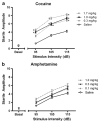Effects of cocaine self-administration history under limited and extended access conditions on in vivo striatal dopamine neurochemistry and acoustic startle in rhesus monkeys
- PMID: 19365621
- PMCID: PMC2796974
- DOI: 10.1007/s00213-009-1534-3
Effects of cocaine self-administration history under limited and extended access conditions on in vivo striatal dopamine neurochemistry and acoustic startle in rhesus monkeys
Abstract
Rationale: The transition from infrequent and controlled cocaine use to dependence may involve enduring changes in neurobiology as a consequence of persistent drug use.
Objective: The present study utilized an intravenous drug self-administration protocol of increasing cocaine access to evaluate potential changes in dopamine function in vivo, including changes in sensitivity to psychostimulants.
Materials and methods: Drug-naïve rhesus monkeys were provided limited access (1 h) to cocaine self-administration for 60 days followed by 60 days under an extended access condition (4 h). Basal levels of striatal extracellular dopamine and its metabolites, as well as the effectiveness of cocaine and amphetamine to elevate dopamine, were determined with in vivo microdialysis before the initiation of cocaine self-administration and during limited and extended access. The effect of cocaine and amphetamine on the acoustic startle response was also examined to assess complementary behavioral changes as a function of drug history.
Results: Extended access to cocaine self-administration lead to increased daily intake compared to limited access conditions but did not result in escalated intake over time. However, cocaine- and amphetamine-induced increases in striatal dopamine were diminished as a function of cocaine self-administration history. Surprisingly, there was no effect of drug-taking history on sensitivity to psychostimulant-induced enhancement of startle amplitude.
Conclusions: The present experiments provide evidence of a hypofunctional dopamine system that is not associated with an escalation in drug intake or reflected in measures of acoustic startle.
Figures





Similar articles
-
Impact of self-administered cocaine and cocaine cues on extracellular dopamine in mesolimbic and sensorimotor striatum in rhesus monkeys.J Neurosci. 2000 May 15;20(10):3874-83. doi: 10.1523/JNEUROSCI.20-10-03874.2000. J Neurosci. 2000. PMID: 10804227 Free PMC article.
-
Behavioral and neurochemical effects of cocaine and diphenhydramine combinations in rhesus monkeys.Psychopharmacology (Berl). 2009 Aug;205(3):467-74. doi: 10.1007/s00213-009-1555-y. Epub 2009 May 9. Psychopharmacology (Berl). 2009. PMID: 19430765 Free PMC article.
-
Long-term cocaine self-administration under fixed-ratio and second-order schedules in monkeys.Psychopharmacology (Berl). 2007 Apr;191(2):287-95. doi: 10.1007/s00213-006-0665-z. Epub 2007 Jan 10. Psychopharmacology (Berl). 2007. PMID: 17216155
-
Dose-dependent effect of ethanol on extracellular dopamine in mesolimbic striatum of awake rhesus monkeys: comparison with cocaine across individuals.Psychopharmacology (Berl). 2002 Dec;165(1):67-76. doi: 10.1007/s00213-002-1233-9. Epub 2002 Oct 10. Psychopharmacology (Berl). 2002. PMID: 12474120
-
Acute brain metabolic effects of cocaine in rhesus monkeys with a history of cocaine use.Brain Imaging Behav. 2010 Dec;4(3-4):212-9. doi: 10.1007/s11682-010-9100-5. Brain Imaging Behav. 2010. PMID: 20680706 Free PMC article.
Cited by
-
Kappa-opioid receptor signaling in the striatum as a potential modulator of dopamine transmission in cocaine dependence.Front Psychiatry. 2013 Jun 3;4:44. doi: 10.3389/fpsyt.2013.00044. eCollection 2013. Front Psychiatry. 2013. PMID: 23760592 Free PMC article.
-
Serotonin 2A receptors differentially contribute to abuse-related effects of cocaine and cocaine-induced nigrostriatal and mesolimbic dopamine overflow in nonhuman primates.J Neurosci. 2013 Aug 14;33(33):13367-74. doi: 10.1523/JNEUROSCI.1437-13.2013. J Neurosci. 2013. PMID: 23946394 Free PMC article.
-
Logical fallacies and misinterpretations that hinder progress in translational addiction neuroscience.J Exp Anal Behav. 2022 May;117(3):384-403. doi: 10.1002/jeab.757. Epub 2022 Apr 1. J Exp Anal Behav. 2022. PMID: 35362559 Free PMC article.
-
Functional consequences of cocaine re-exposure after discontinuation of cocaine availability.Neuropharmacology. 2014 Oct;85:528-37. doi: 10.1016/j.neuropharm.2014.06.003. Epub 2014 Jun 19. Neuropharmacology. 2014. PMID: 24953829 Free PMC article.
-
Limited versus extended cocaine intravenous self-administration: Behavioral effects and electrophysiological changes in insular cortex.CNS Neurosci Ther. 2021 Feb;27(2):196-205. doi: 10.1111/cns.13469. Epub 2020 Oct 29. CNS Neurosci Ther. 2021. PMID: 33118700 Free PMC article.
References
-
- Adams JU, Efferen TR, Duncan EJ, Rotrosen J. Prepulse inhibition of the acoustic startle response in cocaine-withdrawn rats. Pharmacol Biochem Behav. 2001;68:753–759. - PubMed
-
- Ahmed SH, Cador M. Dissociation of psychomotor sensitization from compulsive cocaine consumption. Neuropsychopharmacology. 2006;31:563–571. - PubMed
-
- Ahmed SH, Koob GF. Transition from moderate to excessive drug intake: change in hedonic set point. Science. 1998;282:298–300. - PubMed
-
- Ahmed SH, Koob GF. Long-lasting increase in the set point for cocaine self-administration after escalation in rats. Psychopharmacology. 1999;146:303–312. - PubMed
-
- Ahmed SH, Koob GF. Changes in response to a dopamine receptor antagonist in rats with escalating cocaine intake. Psychopharmacology. 2004;172:450–454. - PubMed
Publication types
MeSH terms
Substances
Grants and funding
LinkOut - more resources
Full Text Sources

